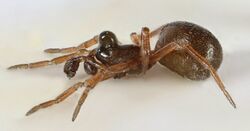Biology:Pelecopsis
From HandWiki
Short description: Genus of spiders
| Pelecopsis | |
|---|---|

| |
| P. nemoralis | |
| Scientific classification | |
| Domain: | Eukaryota |
| Kingdom: | Animalia |
| Phylum: | Arthropoda |
| Subphylum: | Chelicerata |
| Class: | Arachnida |
| Order: | Araneae |
| Infraorder: | Araneomorphae |
| Family: | Linyphiidae |
| Genus: | Pelecopsis Simon, 1864[1] |
| Type species | |
| P. elongata (Wider, 1834)
| |
| Species | |
|
92, see text | |
| Synonyms[1] | |
Pelecopsis is a genus of dwarf spiders that was first described by Eugène Louis Simon in 1864.[4]
Species
(As of May 2021) it contains ninety-two species and four subspecies:[1]
- P. agaetensis Wunderlich, 1987 – Canary Is.
- P. albifrons Holm, 1979 – Kenya
- P. alpica Thaler, 1991 – Switzerland, Austria, Italy
- P. alticola (Berland, 1936) – Kenya
- Pelecopsis a. elgonensis (Holm, 1962) – Uganda
- Pelecopsis a. kenyensis (Holm, 1962) – Kenya
- Pelecopsis a. kivuensis (Miller, 1970) – Congo
- P. amabilis (Simon, 1884) – Algeria
- P. aureipes Denis, 1962 – Morocco
- P. biceps (Holm, 1962) – Tanzania
- P. bicornuta Hillyard, 1980 – Spain, Morocco
- P. bigibba Seo, 2018 – Korea
- P. bishopi Kaston, 1945 – USA
- P. brunea Seo, 2018 – Korea
- P. bucephala (O. Pickard-Cambridge, 1875) – Western Mediterranean
- P. capitata (Simon, 1884) – France
- P. cedricola Bosmans & Abrous, 1992 – Algeria
- P. coccinea (O. Pickard-Cambridge, 1875) – Spain, Morocco
- P. crassipes Tanasevitch, 1987 – Russia, Central Asia
- P. denisi Brignoli, 1983 – Andorra, France
- P. digitulus Bosmans & Abrous, 1992 – Algeria, France (Corsica)
- P. dorniana Heimer, 1987 – Russia, Mongolia
- P. elongata (Wider, 1834) (type) – Europe, Israel
- P. eminula (Simon, 1884) – Spain, France, Italy
- P. flava Holm, 1962 – Uganda, Congo
- P. fornicata Miller, 1970 – Congo
- P. fulva Holm, 1962 – Uganda
- P. hamata Bosmans, 1988 – Cameroon
- P. hipporegia (Denis, 1968) – Algeria, Tunisia
- P. humiliceps Holm, 1979 – Kenya, Uganda
- P. indus Tanasevitch, 2011 – India, Pakistan
- P. inedita (O. Pickard-Cambridge, 1875) – Canary Is., Mediterranean
- P. infusca Holm, 1962 – Uganda
- P. intricata Jocqué, 1984 – South Africa
- P. janus Jocqué, 1984 – South Africa, Lesotho
- P. kabyliana Bosmans & Abrous, 1992 – Algeria
- P. kalaensis Bosmans & Abrous, 1992 – Algeria
- P. laptevi Tanasevitch & Fet, 1986 – Macedonia, Ukraine, Iran, Central Asia
- P. leonina (Simon, 1884) – Algeria
- P. levantensis Tanasevitch, 2016 – Israel
- P. litoralis Wunderlich, 1987 – Canary Is.
- P. loksai Szinetár & Samu, 2003 – Hungary, Macedonia
- P. lunaris Bosmans & Abrous, 1992 – Algeria
- P. major (Denis, 1945) – Algeria
- P. malawiensis Jocqué, 1977 – Malawi
- P. margaretae Georgescu, 1975 – Romania
- P. medusoides Jocqué, 1984 – South Africa
- P. mengei (Simon, 1884) – North America, Europe, Russia (European to Far East), Japan
- P. minor Wunderlich, 1995 – Mongolia
- P. modica Hillyard, 1980 – Spain, Morocco
- P. moesta (Banks, 1892) – USA
- P. monsantensis Bosmans & Crespo, 2010 – Portugal
- P. montana Seo, 2018 – Korea
- P. moschensis (Caporiacco, 1947) – Tanzania
- P. mutica Denis, 1958 – France
- P. nigriceps Holm, 1962 – Kenya, Uganda
- P. nigroloba Fei, Gao & Zhu, 1995 – Russia, China
- P. odontophora (Kulczyński, 1895) – Georgia
- P. oranensis (Simon, 1884) – Morocco, Algeria
- P. oujda Bosmans & Abrous, 1992 – Morocco
- P. palmgreni Marusik & Esyunin, 1998 – Russia, Kazakhstan
- P. papillii Scharff, 1990 – Tanzania
- P. parallela (Wider, 1834) – Europe, Turkey, Russia to Kazakhstan
- P. paralleloides Tanasevitch & Fet, 1986 – Central Asia
- P. partita Denis, 1954 – France
- P. parvicollis Wunderlich, 1995 – Mongolia
- P. parvioculis Miller, 1970 – Angola
- P. pasteuri (Berland, 1936) – Tanzania
- P. pavesii Bosmans & Hervé, 2021 – Tunisia
- P. pavida (O. Pickard-Cambridge, 1872) – Greece, Israel
- P. physeter (Fage, 1936) – Congo, Rwanda, Kenya, Tanzania
- P. pooti Bosmans & Jocqué, 1993 – Spain
- P. proclinata Bosmans, 1988 – Cameroon
- P. punctilineata Holm, 1964 – Congo, Rwanda
- P. punctiseriata (Bösenberg & Strand, 1906) – Japan
- P. radicicola (L. Koch, 1872) – Europe
- P. reclinata (Holm, 1962) – Kenya, Uganda
- P. riffensis Bosmans & Abrous, 1992 – Morocco
- P. robusta Weiss, 1990 – Romania
- P. ruwenzoriensis (Holm, 1962) – Uganda
- P. sanje Scharff, 1990 – Tanzania
- P. sculpta (Emerton, 1917) – Canada
- Pelecopsis s. digna Chamberlin & Ivie, 1939 – USA
- P. senecicola Holm, 1962 – Uganda
- P. subflava Russell-Smith & Jocqué, 1986 – Kenya
- P. suilla (Simon, 1884) – Algeria
- P. susannae (Simon, 1915) – Portugal, France, Britain
- P. tenuipalpis Holm, 1979 – Uganda
- P. topcui (Türkeş, Karabulut, Demir & Seyyar, 2015) – Turkey
- P. tybaertielloides Jocqué, 1984 – Kenya
- P. unimaculata (Banks, 1892) – USA
- P. varians (Holm, 1962) – Kenya, Uganda
See also
References
- ↑ 1.0 1.1 1.2 Gen. Pelecopsis Simon, 1864. Natural History Museum Bern. 2019. doi:10.24436/2. http://www.wsc.nmbe.ch/genus/1542. Retrieved 2019-06-19.
- ↑ Millidge, A. F. (1977). "The conformation of the male palpal organs of linyphiid spiders, and its application to the taxonomic and phylogenetic analysis of the family (Araneae: Linyphiidae)". Bulletin of the British Arachnological Society 4: 21.
- ↑ Wiehle, H. (1960). "Spinnentiere oder Arachnoidea (Araneae). XI. Micryphantidae-Zwergspinnen". Die Tierwelt Deutschlands 47: 34.
- ↑ Simon, E (1864). Histoire naturelle des araignées (aranéides). Paris: Roret. doi:10.5962/bhl.title.47654. https://archive.org/details/histoirenaturell00sim.
Wikidata ☰ Q784383 entry
 |

